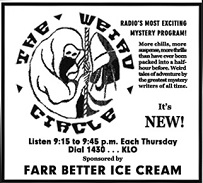
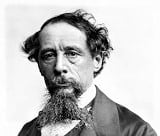 The Weird Circle (1943-45) aired “Dr. Manette’s Manuscript” on October 7, 1943 as the 14th of its 78 episodes. Weird Circle was produced and transcribed in the New York City studios of RCA with enough scripts for two seasons. According to Golden Age Radio historian Karl Schadow: “There were a total of 78 episodes but these were produced in blocks of 13 after the initial group of 26 episodes. Thus, there were not two distinct 39-episode seasons [editor’s note: as some websites proclaim]. There were no ‘seasons’ for The Weird Circle as it was a transcribed series. It was licensed to individual sponsors, stations and ad agencies but not networks.” It was then licensed for syndication to markets across the country and in Canada, to air at a time of each station’s choosing. Thus, it has been almost impossible to trace the very first-ever airing of any given episode (and many were re-aired into the 1950s). This particular episode aired from WGN in Chicago, one of the Mutual Broadcasting System’s powerhouse stations. Weird Circle is considered a fine example of the paranormal and supernatural horror genres. Most of the radio scripts were adapted from the works of Poe, de Balzac, Wilkie Collins, Goethe, Hawthorne, Charlotte Bronte, Daniel DeFoe and many others.
The Weird Circle (1943-45) aired “Dr. Manette’s Manuscript” on October 7, 1943 as the 14th of its 78 episodes. Weird Circle was produced and transcribed in the New York City studios of RCA with enough scripts for two seasons. According to Golden Age Radio historian Karl Schadow: “There were a total of 78 episodes but these were produced in blocks of 13 after the initial group of 26 episodes. Thus, there were not two distinct 39-episode seasons [editor’s note: as some websites proclaim]. There were no ‘seasons’ for The Weird Circle as it was a transcribed series. It was licensed to individual sponsors, stations and ad agencies but not networks.” It was then licensed for syndication to markets across the country and in Canada, to air at a time of each station’s choosing. Thus, it has been almost impossible to trace the very first-ever airing of any given episode (and many were re-aired into the 1950s). This particular episode aired from WGN in Chicago, one of the Mutual Broadcasting System’s powerhouse stations. Weird Circle is considered a fine example of the paranormal and supernatural horror genres. Most of the radio scripts were adapted from the works of Poe, de Balzac, Wilkie Collins, Goethe, Hawthorne, Charlotte Bronte, Daniel DeFoe and many others.
“Dr. Manette’s Manuscript” is a very freely adapted story pulled from Charles Dickens’s (1812-1870) 1859 novel A Tale of Two Cities. This radio script varies widely from the longer and more convoluted story found in the novel and begins here with the manuscript and its story–told in flashback–of one Dr. Manette who is asked to perform a task he cannot refuse, a dying woman who appears to be driven to madness (as her wailing and moaning duly attests), certain well to do people of the French aristocracy living in Paris around the year 1751, and Dr. Manette’s relationship to them and how he gets sucked into their lives to his eventual detriment. At the center of it all, as you will soon hear, is a certain graveyard, and the mystery surrounding the number 12 which seems to be at the heart of this Machiavellian tale. To compare this radio adaptation with the written story you may read the complete text here. It’s definitely worth reading. In the mean time, never let it be said that Old Time Radio failed to provide entertainment for the well educated and cultured among its vast listening audience, as this offering is brought to you from a literary classic that is estimated to have sold in the neighborhood of 200 million copies worldwide.
Play Time: 26:27
{A few weeks prior to Halloween found the neighborhood ghouls and goblins at their nearby newsstand picking up a new batch of their favorite pulp reading material. fantastic Adventures (1939-53), never at a loss for colorful material to stir young imaginations, may have plastered in large letters on the cover of the issue below an unintentionally humorous (if you were an adult) story title. The magazine was a monthly through August of 1943 but with this issue became a bi-monthly. Jungle Stories (1938-54), always a favorite with its popular Ki-Gor, Lord of the Jungle stories, also attracted young male readers with at least one scantily clad woman in distress on virtually every cover. It was a quarterly in 1943. The Shadow (1931-49), though perhaps a tad past its prime of the 1930s, was still a popular magazine in 1943. In fact, it was so popular and sold so many copies that it was a bi-weekly (that’s twice a month) publication right up until its March 1st, 1943 issue, when it would then switch to a monthly schedule.]
[Left: fantastic Adventures, October 1943 – Center: Jungle Stories, Fall 1943 – Right: The Shadow, October 1943]
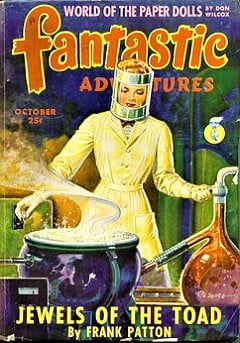
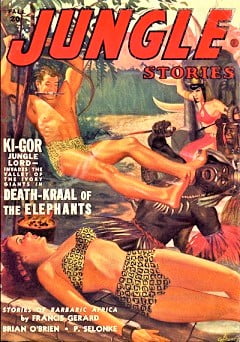
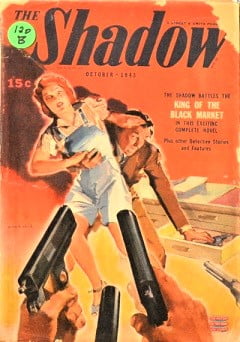
To view the entire list of weekly Old Time Radio episodes at Tangent Online, click here.